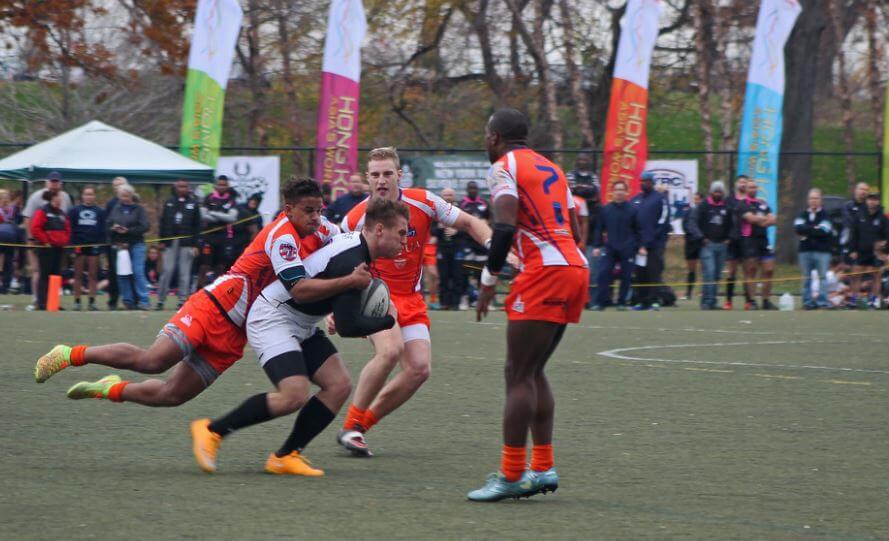Rugby Sevens

The famous rugby sevens is an adaption of the original game of rugby. The main difference between them is the number of players and the fast pace of the game. Aside from this, there are other differences that you should know about. Read about these in our post today!
You may recall a rugby match that was a little different than the standard one while watching the Olympics or another international competition. That’s because you were watching rugby sevens, which is also called, seven-a-side or simply, sevens. So, what’s there to know?
Seven important facts about rugby sevens
1. History and evolution
This sport started in 1883. Ned Haig invented the games as a means to raise money for his club. But, rugby sevens didn’t see an official match until 1873, which took place in Scotland.
The first World Cup Sevens took place in 1993. Some years after, in 1999, the World Rugby Sevens Series took off as well. The World Rugby Seven Series consists of a set of events (usually 7 to 10 events) that determine national standings.
As for women’s leagues, the first World Rugby Sevens competition took place in 1997, Hong Kong. And since 2009, women have also had their own league in the World Cup Sevens. Women also have had their own World Rugby Sevens Series since 2011.
2. Regulations of rugby sevens
Rule-wise, rugby sevens is very similar to the original version. The rules are almost identical and the field is exactly the same— 100 m long and 70 m wide. The try lines, posts and point-system remain the same as well.
How the game is timed is quite fascinating. Teams play two seven-minute halves for a total of 14 minutes game time and referees stop the clock when the ball goes out of play. In between the halves, there’s a two-minute half-time. If the teams tie, they play two additional five-minute halves. Because of the fast-paced matches, several rugby games or even tournaments can start and finish in a single day.
As for technique and skills, this discipline is identical to traditional rugby. Players always pass the ball backward– except during kick-offs– and can tackle their opponents for the ball.

3. Gameplay
Not surprisingly, this discipline is extremely active. Just consider the fact that the game uses a field normally suited for 30 players for just 14 men or women.
The games are a real treat to watch; some would even say that they’re even more exciting than traditional rugby matches. Players don’t only need to be strong enough to handle the physical contact; they must also have the stamina and techniques to cover a large playing area.
4. Rugby sevens positions
As with any other team sport, there are various playing positions in rugby sevens. Each position calls for certain physical skills and techniques in addition to a player’s personal preference as well.
There are three main functions, which are identical to those in traditional rugby:
- Forwards: the beefiest of the bunch, they aim to break through their rival’s defense and give more space to their backs.
- Scrum-backs: an essential role in leading attacks and uniting the forwards.
- Backs: these players are swift and can cut through gaps in the opposing defense to score points.
5. Differences with traditional rugby
Just as the number of players differs in the two sports, the substitution-system is different as well. Rugby sevens don’t allow eight substitutions per team. Instead, each team has five substitutions and interchanges.
Furthermore, the half-time is only 2-minutes long instead of 10 minutes and the scrum only has three players instead of eight. In addition, players must kick the ball over the crossbar to score a conversion.
Moving on, yellow cards mean a 2-minute suspension for the player in question instead of 10 minutes. However, despite the shorter penalty, the suspension hits harder, as losing a player limits the teams more than it would in the case of a 15-player team.
6. Notable teams
Just the same as traditional rugby, New Zealand is one of the powerhouses in rugby sevens in both male and female leagues. New Zealand has won 11 of the 14 Men’s World Rugby Sevens Series. Fiji, South Africa, and Samoa are also notable national teams.

Australia, Argentina, and Wales also have strong teams. France and Scotland, on the other hand, don’t boast such a strong sevens team as they do in traditional rugby.
7. Rugby sevens in the Olympic Games
In the 20th-century Olympic Games, rugby became an official Olympic sport. However, it was removed in 1924 and only reappeared in 2016 in Rio de Janeiro as rugby sevens.
In Rio de Janeiro, Fiji, Great Britan, and South Africa won the gold, silver and bronze medals respectively. Meanwhile, in the women’s game, Australia, New Zealand and Canada won a spot on the podium.
The famous rugby sevens is an adaption of the original game of rugby. The main difference between them is the number of players and the fast pace of the game. Aside from this, there are other differences that you should know about. Read about these in our post today!
You may recall a rugby match that was a little different than the standard one while watching the Olympics or another international competition. That’s because you were watching rugby sevens, which is also called, seven-a-side or simply, sevens. So, what’s there to know?
Seven important facts about rugby sevens
1. History and evolution
This sport started in 1883. Ned Haig invented the games as a means to raise money for his club. But, rugby sevens didn’t see an official match until 1873, which took place in Scotland.
The first World Cup Sevens took place in 1993. Some years after, in 1999, the World Rugby Sevens Series took off as well. The World Rugby Seven Series consists of a set of events (usually 7 to 10 events) that determine national standings.
As for women’s leagues, the first World Rugby Sevens competition took place in 1997, Hong Kong. And since 2009, women have also had their own league in the World Cup Sevens. Women also have had their own World Rugby Sevens Series since 2011.
2. Regulations of rugby sevens
Rule-wise, rugby sevens is very similar to the original version. The rules are almost identical and the field is exactly the same— 100 m long and 70 m wide. The try lines, posts and point-system remain the same as well.
How the game is timed is quite fascinating. Teams play two seven-minute halves for a total of 14 minutes game time and referees stop the clock when the ball goes out of play. In between the halves, there’s a two-minute half-time. If the teams tie, they play two additional five-minute halves. Because of the fast-paced matches, several rugby games or even tournaments can start and finish in a single day.
As for technique and skills, this discipline is identical to traditional rugby. Players always pass the ball backward– except during kick-offs– and can tackle their opponents for the ball.

3. Gameplay
Not surprisingly, this discipline is extremely active. Just consider the fact that the game uses a field normally suited for 30 players for just 14 men or women.
The games are a real treat to watch; some would even say that they’re even more exciting than traditional rugby matches. Players don’t only need to be strong enough to handle the physical contact; they must also have the stamina and techniques to cover a large playing area.
4. Rugby sevens positions
As with any other team sport, there are various playing positions in rugby sevens. Each position calls for certain physical skills and techniques in addition to a player’s personal preference as well.
There are three main functions, which are identical to those in traditional rugby:
- Forwards: the beefiest of the bunch, they aim to break through their rival’s defense and give more space to their backs.
- Scrum-backs: an essential role in leading attacks and uniting the forwards.
- Backs: these players are swift and can cut through gaps in the opposing defense to score points.
5. Differences with traditional rugby
Just as the number of players differs in the two sports, the substitution-system is different as well. Rugby sevens don’t allow eight substitutions per team. Instead, each team has five substitutions and interchanges.
Furthermore, the half-time is only 2-minutes long instead of 10 minutes and the scrum only has three players instead of eight. In addition, players must kick the ball over the crossbar to score a conversion.
Moving on, yellow cards mean a 2-minute suspension for the player in question instead of 10 minutes. However, despite the shorter penalty, the suspension hits harder, as losing a player limits the teams more than it would in the case of a 15-player team.
6. Notable teams
Just the same as traditional rugby, New Zealand is one of the powerhouses in rugby sevens in both male and female leagues. New Zealand has won 11 of the 14 Men’s World Rugby Sevens Series. Fiji, South Africa, and Samoa are also notable national teams.

Australia, Argentina, and Wales also have strong teams. France and Scotland, on the other hand, don’t boast such a strong sevens team as they do in traditional rugby.
7. Rugby sevens in the Olympic Games
In the 20th-century Olympic Games, rugby became an official Olympic sport. However, it was removed in 1924 and only reappeared in 2016 in Rio de Janeiro as rugby sevens.
In Rio de Janeiro, Fiji, Great Britan, and South Africa won the gold, silver and bronze medals respectively. Meanwhile, in the women’s game, Australia, New Zealand and Canada won a spot on the podium.
All cited sources were thoroughly reviewed by our team to ensure their quality, reliability, currency, and validity. The bibliography of this article was considered reliable and of academic or scientific accuracy.
- Manual para empezar a jugar al rugby. Training Passport. Disponible en: https://passport.worldrugby.org/?page=beginners&p=3
- Rugby 7. Wikipedia. Disponible en: https://es.wikipedia.org/wiki/Rugby_7#Variaciones_de_las_reglas_de_juego
- Enciclopedia visual JJOO Rio 2016: Rugby a 7. Marca. https://www.marca.com/juegos-olimpicos/rugby/todo-sobre.html
This text is provided for informational purposes only and does not replace consultation with a professional. If in doubt, consult your specialist.








